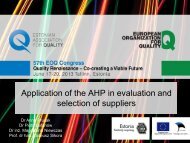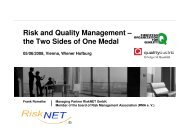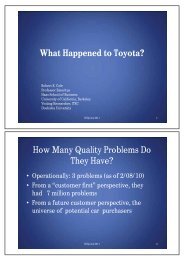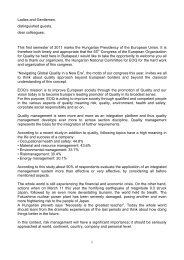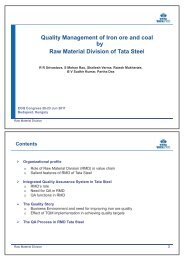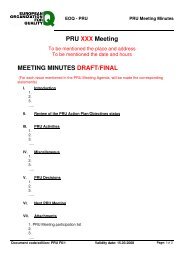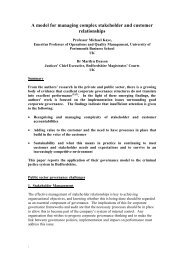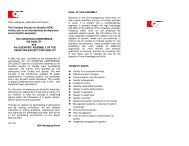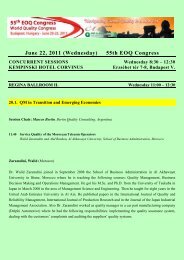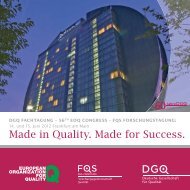a case study approach to the economic evaluation of iso 9001 ...
a case study approach to the economic evaluation of iso 9001 ...
a case study approach to the economic evaluation of iso 9001 ...
You also want an ePaper? Increase the reach of your titles
YUMPU automatically turns print PDFs into web optimized ePapers that Google loves.
A CASE STUDY APPROACH<br />
TO THE ECONOMIC EVALUATION OF<br />
ISO <strong>9001</strong> CERTIFICATION<br />
Paulo Sampaio 1* , Pedro Saraiva 2 , António Guimarães Rodrigues 3<br />
1*. Researcher, PhD, University <strong>of</strong> Minho, Production and Systems Department, Campus de<br />
Gualtar, 4710-057 Braga, Portugal, Phone: +351 253 604 756, paulosampaio@dps.uminho.pt<br />
2. Associate Pr<strong>of</strong>essor, University <strong>of</strong> Coimbra, Chemical Engineering Department, Pólo II<br />
Pinhal de Marrocos, 3030-290 Coimbra, Portugal.<br />
3. Full Pr<strong>of</strong>essor, University <strong>of</strong> Minho, Production and Systems Department, Campus de<br />
Gualtar, 4710-057 Braga, Portugal.<br />
Summary<br />
This paper presents <strong>the</strong> results obtained from <strong>study</strong>ing <strong>the</strong> <strong>economic</strong> impact <strong>of</strong> quality<br />
management systems, based on <strong>the</strong> <strong>case</strong> <strong>study</strong> methodology. The sample <strong>of</strong> companies that<br />
we used comprises three companies that became ISO <strong>9001</strong> certified based on internal<br />
motivation, and three companies that have implemented <strong>the</strong>ir quality management system<br />
driven mostly by external motivation.<br />
Keywords<br />
ISO 9000, Economic-financial performance, Case <strong>study</strong> methodology.<br />
INTRODUCTION<br />
A number <strong>of</strong> studies have been carried out that try <strong>to</strong> relate <strong>the</strong> impact <strong>of</strong> quality management<br />
practices on organizational performance. The majority <strong>of</strong> <strong>the</strong>m conclude that <strong>the</strong>re is a<br />
positive relationship between <strong>the</strong> implementation <strong>of</strong> quality management practices and<br />
organizational performance improvement (Mann and Kehoe, 1994; Maani et al., 1994;<br />
Wisner and Eakins, 1994; Adam Jr. et al., 1997; Curkovic and Pagel, 1999; Terziovski and<br />
Samson, 1999; Gupta, 2000; Romano, 2000; Wi<strong>the</strong>rs and Ebrahimpour, 2000, 2001; Lee et<br />
al., 2001; Singels et al., 2001; Boulter and Bendell, 2002; Dick et al., 2002; Ozgur et al.,<br />
2002; Tarí and Molina, 2002; Tarí and Sabater, 2004; Quazi and Jacobs, 2004).<br />
Gupta’s (2000) results showed that ISO <strong>9001</strong> certified companies differed from non-certified<br />
ones on “technological management”, “quality management control”, “causes <strong>of</strong> poor quality”<br />
and “quality control techniques used”. Overall, in <strong>the</strong>se categories, <strong>the</strong> usage mean values<br />
were higher for ISO <strong>9001</strong> companies. Romano (2000) has observed statistically significant<br />
improvements after certification, concerning “quality performance in production and on <strong>the</strong><br />
reliability <strong>of</strong> <strong>the</strong> production system” and “external quality performances”. He also verified<br />
that “non-quality costs” diminished significantly after certification. Ozgur et al. (2002)<br />
observed that, for <strong>the</strong> majority <strong>of</strong> quality <strong>to</strong>ols, <strong>the</strong> level <strong>of</strong> usage was higher for ISO <strong>9001</strong><br />
certified firms. Concerning <strong>the</strong> services sec<strong>to</strong>r, Dick et al. (2002) have concluded that ISO<br />
<strong>9001</strong> certification makes a pr<strong>of</strong>ound difference in <strong>the</strong> ways quality is perceived and measured.
Although <strong>the</strong> majority <strong>of</strong> <strong>the</strong> studies carried out state that <strong>the</strong>re is a positive relationship<br />
between ISO <strong>9001</strong> certification and performance, <strong>the</strong>re is a group <strong>of</strong> authors that did not find<br />
evidence <strong>of</strong> such a relationship (Terziovski et al., 1997; Quazi et al., 2002; Conca et al.,<br />
2004). Results obtained by Terziovski et al. (1997) showed that <strong>the</strong> presence or absence <strong>of</strong><br />
ISO <strong>9001</strong> certification is a poor predic<strong>to</strong>r <strong>of</strong> organizational performance and quality. Quazi et<br />
al. (2002) concluded that <strong>the</strong>re was no statistically significant relationship between ISO <strong>9001</strong><br />
certification status, quality management practices and quality results.<br />
There seems <strong>to</strong> be a strong relationship between companies’ certification motivations and<br />
resultant benefits. When firms are reacting <strong>to</strong> external pressure for certification, <strong>the</strong>y may face<br />
ISO <strong>9001</strong> registration as <strong>the</strong> prime objective and adopt a minimalist <strong>approach</strong> <strong>to</strong> achieving it.<br />
Such firms obtain quality certification, but <strong>the</strong>y may not fully value quality management<br />
systems, and thus will achieve limited benefits.<br />
According <strong>to</strong> Garvin (1984, cited in Sousa and Voss, 2002) <strong>the</strong> effect <strong>of</strong> quality on business<br />
performance (financial perspective) is based on two main routes: manufacturing and market.<br />
In <strong>the</strong> manufacturing route, improving internal process quality results in better operational<br />
performance that leads <strong>to</strong> business performance. In <strong>the</strong> market route, improvement <strong>of</strong> product<br />
quality will influence marketing business performance.<br />
According <strong>to</strong> Sousa and Voss (2002), quality management practices have a significant and<br />
strong impact on quality and operational performance. However, <strong>the</strong>ir impact on business<br />
performance is weaker and not always significant. Brust and Gryna (2002) stated that, in <strong>the</strong><br />
following five <strong>economic</strong> areas, quality is <strong>of</strong> paramount importance: (1) exports competitive<br />
advantage; (2) national trade deficits; (3) <strong>economic</strong> growth; (4) productivity and cus<strong>to</strong>mer<br />
satisfaction; (5) standardization.<br />
A systematic <strong>approach</strong> <strong>to</strong> quality improvement results in two key fac<strong>to</strong>rs that drive financial<br />
performance: (1) it generates greater value for cus<strong>to</strong>mers, building market share and revenues;<br />
(2) it lowers costs, increasing margins and asset usage (George, 2002).<br />
Despite all <strong>of</strong> <strong>the</strong> studies carried out in this area, <strong>the</strong> conclusions reached still have a<br />
contradic<strong>to</strong>ry nature. Some authors conclude that <strong>the</strong>re is a positive relationship between ISO<br />
<strong>9001</strong> certification and companies’ financial improvement (Maani et al., 1994; Wisner and<br />
Eakins, 1994; LRQA, 1996; Chapman et al., 1997; Janas and Luczak, 2002; Lee et al., 2001;<br />
Beirão and Sarsfield Cabral, 2002; Nicolau and Sellers, 2002; Wayhan et al., 2002; Chow-<br />
Chua et al., 2003; Dimara et al., 2004; Naser et al., 2004). However, o<strong>the</strong>rs do not find<br />
evidence <strong>of</strong> such a relationship (Adam Jr. et al., 1997; Kannan et al., 1999; Haversjo, 2000;<br />
Lima et al., 2000; Heras et al., 2001, 2002a, 2002b; Aarts and Vos, 2001; Corbett et al., 2002,<br />
2005; Tsekouras et al., 2002; Martinez-Costa and Martinez-Lorente, 2003).<br />
Heras et al. (2001, 2002a, 2002b), regarding better financial performance presented by ISO<br />
<strong>9001</strong> certified companies, argued that: (1) one must consider <strong>the</strong> multitude <strong>of</strong> variables that<br />
influence or can influence a company’s business performance; (2) it is important that <strong>the</strong><br />
characteristics <strong>of</strong> <strong>the</strong> samples used are analysed in greater detail, because it is possible that<br />
higher pr<strong>of</strong>itability <strong>of</strong> <strong>the</strong> certified companies may have <strong>to</strong> do with <strong>the</strong> fact that certified firms<br />
belong <strong>to</strong> activity sec<strong>to</strong>rs that enjoy greater pr<strong>of</strong>itability levels; (3) higher pr<strong>of</strong>itability rates<br />
verified among ISO <strong>9001</strong> companies may be related <strong>to</strong> <strong>the</strong> most pr<strong>of</strong>itable companies, being<br />
those that have a greater propensity <strong>to</strong> be ISO <strong>9001</strong> certified.
Overall, no consistent evidence could be found in <strong>the</strong> literature concerning <strong>the</strong> real ISO <strong>9001</strong><br />
impact on companies’ business performance, thus motivating <strong>the</strong> fieldwork that we decided <strong>to</strong><br />
carry out.<br />
CASE STUDIES FOR ISO <strong>9001</strong> PERFORMANCE IMPACT EVALUATION<br />
We conducted six <strong>case</strong> studies, in order <strong>to</strong> analyse <strong>the</strong> impact <strong>of</strong> ISO <strong>9001</strong> on companies’<br />
financial performance. Our goal was <strong>to</strong> reconstruct <strong>the</strong> <strong>economic</strong>-financial company his<strong>to</strong>ry<br />
with <strong>the</strong> aim <strong>of</strong> identifying <strong>the</strong> benefits and costs directly related <strong>to</strong> <strong>the</strong>ir quality management<br />
systems. The time period analysed ranged from <strong>the</strong> year when <strong>the</strong> company decided <strong>to</strong><br />
implement its quality management system up <strong>to</strong> <strong>the</strong> present (2007).<br />
Our <strong>case</strong> <strong>study</strong> methodology was split in<strong>to</strong> three main phases. First we developed <strong>the</strong><br />
framework that we would use in interviews. Then we tested <strong>the</strong> framework in order <strong>to</strong><br />
validate and improve it, by making a pilot <strong>case</strong> <strong>study</strong> in a textile company.<br />
Finally, with a revised framework, we selected six companies for which we had previously<br />
identified what had been <strong>the</strong>ir most important ISO <strong>9001</strong> certification motivation, ei<strong>the</strong>r<br />
internal or external. Thus, we selected three companies that became certified based mainly on<br />
external motivation, and ano<strong>the</strong>r three companies that became certified based mostly on<br />
internal motivation. We tried <strong>to</strong> choose companies that belonged <strong>to</strong> <strong>the</strong> same industrial sec<strong>to</strong>r,<br />
but with different ISO <strong>9001</strong> motivations. However, that was not possible, since some <strong>of</strong> <strong>the</strong><br />
selected companies declined <strong>to</strong> participate in <strong>the</strong> project. To have six companies willing <strong>to</strong><br />
participate, we contacted 11 companies overall. These companies were chosen from a sample<br />
<strong>of</strong> 48 companies for which we were pretty sure about what was <strong>the</strong>ir most important ISO<br />
<strong>9001</strong> certification motivation (Sampaio et al., 2006, 2008, 2009).<br />
The external-motivation companies are from <strong>the</strong> following industrial sec<strong>to</strong>rs:<br />
Company A: EAC 12 – Chemicals, chemical products and fibres.<br />
Company B: EAC 28 – Construction.<br />
Company C: EAC 18 – Machinery and equipment.<br />
The internal-motivation companies are from <strong>the</strong> following industrial sec<strong>to</strong>rs:<br />
Company D: EAC 18 – Machinery and equipment.<br />
Company E: EAC 12 – Chemicals, chemical products and fibres.<br />
Company F: EAC 4 – Textiles and textile products.<br />
The interviews were performed with <strong>the</strong> companies’ quality managers, and for each <strong>of</strong> <strong>the</strong><br />
companies we performed a qualitative analysis and a quantitative analysis. The qualitative<br />
analysis was performed on information collected during <strong>the</strong> interviews with <strong>the</strong> companies’<br />
quality managers. In <strong>the</strong> quantitative analysis we asked <strong>the</strong> companies <strong>to</strong> characterize two<br />
different scenarios: <strong>the</strong> real one, with certification, and ano<strong>the</strong>r one, without it, concerning <strong>the</strong><br />
following financial indica<strong>to</strong>rs:<br />
Sales.<br />
Average price.<br />
Average production cost.
Quality management system implementation and maintenance costs.<br />
Using <strong>the</strong> previous set <strong>of</strong> financial indica<strong>to</strong>rs, we estimated <strong>the</strong> following indica<strong>to</strong>r values:<br />
Operational Results<br />
Operational Results Difference<br />
Sales * (Average price – Average production cost)<br />
Estimated Operational Results with ISO <strong>9001</strong> - Estimated Operational Cost without ISO <strong>9001</strong><br />
We asked <strong>the</strong> companies <strong>to</strong> define <strong>the</strong> above financial indica<strong>to</strong>rs on an annual basis, from <strong>the</strong><br />
year <strong>of</strong> <strong>the</strong> decision <strong>to</strong> implement <strong>the</strong> quality management system, until 2007.<br />
The goal <strong>of</strong> our quantitative analysis was <strong>to</strong> verify if <strong>the</strong>re was any variation in <strong>the</strong><br />
Operational Results from <strong>the</strong> scenario with ISO <strong>9001</strong> certification as compared with <strong>the</strong> one<br />
without ISO <strong>9001</strong> certification.<br />
MAIN RESULTS OBTAINED<br />
Based on <strong>the</strong> developed work we were able <strong>to</strong> find that ISO <strong>9001</strong> certification motivations<br />
(internal or external ones) influence <strong>the</strong> derived benefits. We have also found out that<br />
companies’ motivations can influence <strong>the</strong> organization’s involvement and commitment <strong>to</strong> <strong>the</strong><br />
quality management system. In those companies that became certified based mainly on<br />
internal motivation, <strong>the</strong>re is <strong>of</strong>ten <strong>the</strong> perception that all <strong>the</strong> organization is committed <strong>to</strong> <strong>the</strong><br />
system. That is not <strong>the</strong> <strong>case</strong> when we talk about external motivation-driven companies.<br />
We would like <strong>to</strong> point out that <strong>the</strong> certified companies easily identified <strong>the</strong> costs related <strong>to</strong><br />
<strong>the</strong>ir quality management systems. However, it was very difficult for <strong>the</strong> quality managers <strong>to</strong><br />
quantify <strong>the</strong> direct pr<strong>of</strong>its (or cost reductions) associated with <strong>the</strong> quality management<br />
systems. Quality managers have <strong>the</strong> perception that <strong>the</strong> company’s internal organization has<br />
improved, but <strong>the</strong>y are not able <strong>to</strong> quantify how those improvements translate in<strong>to</strong> <strong>economic</strong><br />
benefits.<br />
Those companies that did present internal motivations have perceived higher benefits than<br />
those that became certified based on external motivations. However, in <strong>the</strong> externalmotivation<br />
companies it was easier <strong>to</strong> quantify increased pr<strong>of</strong>its and sales deriving from ISO<br />
<strong>9001</strong> certification.<br />
Concerning <strong>the</strong> costs related <strong>to</strong> quality management system implementation and maintenance,<br />
it is important <strong>to</strong> point out that <strong>the</strong> <strong>to</strong>tal amount is significantly higher for companies that had<br />
consultants helping <strong>to</strong> implement <strong>the</strong> systems.<br />
For <strong>the</strong> majority <strong>of</strong> <strong>the</strong> <strong>case</strong> studies we have concluded that companies are not able <strong>to</strong> support<br />
<strong>the</strong> fact that quality management system implementation does have a positive impact on<br />
companies’ <strong>economic</strong>-financial performance.
ACKNOWLEDGEMENTS<br />
The authors acknowledge financial support provided by Fundação para a Ciência e a<br />
Tecnologia (FCT) through PhD research grant (BD/16032/2004).<br />
REFERENCES<br />
[1] Aarts, F. and Vos, Ed (2001), The impact <strong>of</strong> ISO registration in New Zealand firms’<br />
performance: a financial perspective, The TQM Magazine, 13(3), pp. 180-191.<br />
[2] Adam Jr., E., Corbett, L., Flores, B., Harr<strong>iso</strong>n, N., Lee, T., Rho, B., Ribera, J., Samson,<br />
D., Westbrook, R., (1997), An international <strong>study</strong> <strong>of</strong> quality improvement <strong>approach</strong> and firm<br />
performance, International Journal <strong>of</strong> Quality & Reliability Management, 17(9), pp. 842-873.<br />
[3] Beirão, G. and Sarsfield Cabral, J. (2002), The reaction <strong>of</strong> <strong>the</strong> Portuguese s<strong>to</strong>ck market<br />
<strong>to</strong> ISO 9000 certification, Total Quality Management, 13(4), pp. 465-474.<br />
[4] Boulter, L. and Bendell, T. (2002), How can ISO 9000:2000 help companies achieve<br />
excellence?, Measuring Business Excellence, 6(2), pp. 37-41.<br />
[5] Brust, P. and Gryna, F. (2002), Quality and Economics: five key issues, Quality<br />
Progress (Oc<strong>to</strong>ber).<br />
[6] Chapman, R., Murray, P., Mellor, R. (1997), Strategic quality management and financial<br />
performance indica<strong>to</strong>rs, International Journal <strong>of</strong> Quality & Reliability Management, 14(4),<br />
pp. 432-448.<br />
[7] Chow-Chua, C., Goh, M., Boon Wan, T. (2003), Does ISO 9000 certification improve<br />
business performance?, International Journal <strong>of</strong> Quality & Reliability Management, 20(8),<br />
pp. 936-953.<br />
[8] Conca, F., Llopis, F., Tarí, J. (2004), Development <strong>of</strong> a measure <strong>to</strong> assess quality<br />
management in certified firms, European Journal <strong>of</strong> Operational Research, 156, pp. 683-697.<br />
[9] Corbett, C., Montes, M., Kirsch, D., Alvarez-Gil., M. (2002), Does ISO 9000<br />
certification pay?, ISO Management Systems (July-August).<br />
[10] Corbett, C., Montes-Sancho, M., Kirsch, D. (2005), The financial impact <strong>of</strong> ISO 9000<br />
certification in <strong>the</strong> US: an empirical analysis, Management Science, 51(7), pp. 1046-1059.<br />
[11] Curkovic, S. and Pagell, M. (1999), A critical examination <strong>of</strong> <strong>the</strong> ability <strong>of</strong> ISO 9000<br />
certification <strong>to</strong> lead <strong>to</strong> a competitive advantage, Journal <strong>of</strong> Quality Management, 4(1), pp. 51-<br />
67.<br />
[12] Dick, G., Gallimore, K., Brown, J. (2002), Does ISO 9000 accreditation make a<br />
pr<strong>of</strong>ound difference <strong>to</strong> <strong>the</strong> way service quality is perceived and measured?, Managing Service<br />
Quality, 12(1), pp. 30-42.<br />
[13] Dimara, E., Sakuras, D., Tsekouras, K., Goutsos, S. (2004), Strategic orientation and<br />
financial performance <strong>of</strong> firms implementing ISO 9000, International Journal <strong>of</strong> Quality &<br />
Reliability Management, 21(1), pp. 72-89.<br />
[14] Gupta, A. (2000), Quality management practices <strong>of</strong> ISO vs. non-ISO companies: a <strong>case</strong><br />
<strong>of</strong> Indian industry, Industrial Management & Data Systems, 100(9), pp. 451-455.<br />
[15] Haversjo, T. (2000), The financial effects <strong>of</strong> ISO 9000 registration for Danish<br />
companies, Managerial Auditing Journal, 15(1), pp. 47-52.
[16] Heras, I., Casadéus, M., Ochoa, C. (2001), Effects <strong>of</strong> ISO 9000 certification on<br />
companies’ pr<strong>of</strong>itability: an empirical <strong>study</strong>, 6 th International Conference on ISO 9000 and<br />
TQM, Ayr, Scotland.<br />
[17] Heras, I., Casadéus, M., Dick, G. (2002a), ISO 9000 certification and <strong>the</strong> bot<strong>to</strong>m line: a<br />
comparative <strong>study</strong> <strong>of</strong> <strong>the</strong> pr<strong>of</strong>itability <strong>of</strong> Basque region companies, Managerial Auditing<br />
Journal, 17(1), pp. 72-78.<br />
[18] Heras, I., Dick, G., Casadéus, M. (2002b), ISO 9000 registration’s impact on sales and<br />
pr<strong>of</strong>itability: a longitudinal analysis <strong>of</strong> performance before and after accreditation,<br />
International Journal <strong>of</strong> Quality & Reliability Management, 19(6), pp. 774-791.<br />
[19] Janas, I. and Luczak, H. (2002), Explorative <strong>study</strong> <strong>of</strong> <strong>the</strong> expected consequences for<br />
existing quality management systems due <strong>to</strong> <strong>the</strong> revision <strong>of</strong> ISO <strong>9001</strong> in certified companies<br />
in Germany, The TQM Magazine, 14(2), pp.127-132.<br />
[20] Kannan, V., Tan, K., Handfield, R., Ghosh, S. (1999), Tools and techniques <strong>of</strong> quality<br />
management: an empirical investigation <strong>of</strong> <strong>the</strong>ir impact on performance, Quality Management<br />
Journal, 6(3), pp. 34-49.<br />
[21] Lee, C., Lee, T., Chang, C. (2001), Quality/productivity practices and company<br />
performance in China, International Journal <strong>of</strong> Quality & Reliability Management, 18(6), pp.<br />
604-625.<br />
[22] Lima, M., Resende, M., Hasenclever, L. (2000), Quality certification and performance<br />
<strong>of</strong> Brazilian firms: an empirical <strong>study</strong>, International Journal <strong>of</strong> Production Economics, 66,<br />
pp. 143-147.<br />
[23] LRQA-Lloyd’s Register Quality Assurance (1996), Fitter Finance: <strong>the</strong> effects <strong>of</strong> ISO<br />
9000 on business performance (available at www.lrqa.com).<br />
[24] Maani, K., Putterill, M., Sluti, D. (1994), Empirical analysis <strong>of</strong> quality improvement in<br />
manufacturing, International Journal <strong>of</strong> Quality & Reliability Management, 11(7), pp. 19-37.<br />
[25] Mann, R. and Kehoe, D. (1994), An <strong>evaluation</strong> <strong>of</strong> <strong>the</strong> effects <strong>of</strong> quality improvement<br />
activities on business performance, International Journal <strong>of</strong> Quality & Reliability<br />
Management, 11(4), pp. 29-44.<br />
[26] Martínez–Costa, M. and Martínez–Lorente, A. (2003), Effects <strong>of</strong> ISO 9000 certification<br />
on firms’ performance: a vision from <strong>the</strong> market, TQM & Business Excellence, 14(10), pp.<br />
1179-1191.<br />
[27] Naser, K., Karbhari, Y., Mokhtar, M. (2004), Impact <strong>of</strong> ISO 9000 registration on<br />
company performance, International Journal <strong>of</strong> Quality & Reliability Management, 19(4), pp.<br />
509-516.<br />
[28] Nicolau, J. and Sellers, R. (2002), The s<strong>to</strong>ck market’s reaction <strong>to</strong> quality certification:<br />
empirical evidence from Spain, European Journal <strong>of</strong> Operational Research, 142, pp. 632-<br />
641.<br />
[29] Ozgur, C., Meek, G., Toker, A. (2002), The impact <strong>of</strong> ISO certification on <strong>the</strong> levels <strong>of</strong><br />
awareness and usage <strong>of</strong> quality <strong>to</strong>ols and concepts: a survey <strong>of</strong> Turkish manufacturing<br />
companies, Quality Management Journal, 9(2), pp. 57-69.<br />
[30] Quazi, H., Hong, C., Meng, C. (2002), Impact <strong>of</strong> ISO 9000 certification on quality<br />
management practices: a comparative <strong>study</strong>, Total Quality Management, 13(1), pp. 53-67.
[31] Quazi, H. and Jacobs, R. (2004), Impact <strong>of</strong> ISO 9000 certification on training and<br />
development activities, International Journal <strong>of</strong> Quality & Reliability Management, 21(5), pp.<br />
497-517.<br />
[32] Romano, P. (2000), ISO 9000: what is its impact on performance?, Quality Management<br />
Journal, 7(3), pp.38-56.<br />
[33] Sampaio, P., Saraiva, P., Guimarães Rodrigues, A. (2006), ISO <strong>9001</strong> certification<br />
research: a State-<strong>of</strong>-<strong>the</strong>-Art, Proceedings <strong>of</strong> <strong>the</strong> ASQ World Conference on Quality<br />
Improvement, Milwaukee, Wisconsin, USA, 2006.<br />
[34] Sampaio, P., Saraiva, P., Guimarães Rodrigues, A. (2008), ISO <strong>9001</strong> Audits: a<br />
Classification Algorithm, Proceedings <strong>of</strong> <strong>the</strong> ASQ World Conference on Quality<br />
Improvement, Hous<strong>to</strong>n, Texas, USA, 2008.<br />
[35] Sampaio, P., Saraiva, P., Guimarães Rodrigues, A. (2009), ISO <strong>9001</strong> certification<br />
research: questions, answers and <strong>approach</strong>es, International Journal <strong>of</strong> Quality & Reliability<br />
Management, 26(1), pp. 38-58.<br />
[36] Singels, J., Ruel, G., van de Water, H. (2001), ISO 9000 series: certification and<br />
performance, International Journal <strong>of</strong> Quality & Reliability Management, 18(1), pp. 62-75.<br />
[37] Sousa, R. and Voss, C. (2002), Quality management re-visited: a reflective review and<br />
agenda for future research, Journal <strong>of</strong> Operations Management, 20, pp. 91-109.<br />
[38] Tarí, J. and Molina, J. (2002), Quality management results in ISO 9000 certified<br />
Spanish firms, The TQM Magazine, 14(4), pp. 232-239.<br />
[39] Tarí, J. and Sabater, V. (2004), Quality <strong>to</strong>ols and techniques: are <strong>the</strong>y necessary for<br />
quality management?, International Journal <strong>of</strong> Production Economics, 92, pp. 267-280.<br />
[40] Terziovski, M., Samson, D., Dow, D. (1997), The business value <strong>of</strong> quality management<br />
systems certification: evidence from Australia and New Zealand, Journal <strong>of</strong> Operations<br />
Management, 15, pp. 1-18.<br />
[41] Terziovski, M. and Samson, D. (1999), The link between <strong>to</strong>tal quality management<br />
practice and organizational performance, International Journal <strong>of</strong> Quality & Reliability<br />
Management, 16(3), pp. 226-237.<br />
[42] Tsekouras, K., Dimara, E., Skuras, D. (2002), Adoption <strong>of</strong> a quality assurance scheme<br />
and its effect on firm performance: a <strong>study</strong> <strong>of</strong> Greek firms implementing ISO 9000, Total<br />
Quality Management, 13(6), pp. 827-841.<br />
[43] Wayhan, V., Kirche, E., Khumawala, B. (2002), ISO 9000 certification: <strong>the</strong> financial<br />
performance implications, Total Quality Management, 13(2), pp. 217-231.<br />
[44] Wisner, J. and Eakins, S. (1994), A performance assessment <strong>of</strong> <strong>the</strong> US Baldrige Quality<br />
Award Winners, International Journal <strong>of</strong> Quality & Reliability Management, 11(2), pp. 8-25.<br />
[45] Wi<strong>the</strong>rs, B. and Ebrahimpour, M. (2000), Does ISO 9000 certification affect <strong>the</strong><br />
dimensions <strong>of</strong> quality used for competitive advantage?, European Management Journal,<br />
18(4), pp. 431-443.<br />
[46] Wi<strong>the</strong>rs, B. and Ebrahimpour, M. (2001), Impacts <strong>of</strong> ISO 9000 registration on European<br />
firms: a <strong>case</strong> analysis, Integrating Manufacturing Systems, 12(2), pp. 139-151.
A Case Study Approach <strong>to</strong> <strong>the</strong><br />
Economic Evaluation <strong>of</strong> ISO <strong>9001</strong><br />
Certification<br />
Paulo Sampaio*, Pedro Saraiva**, A. Guimarães Rodrigues*<br />
* University <strong>of</strong> Minho; ** University <strong>of</strong> Coimbra<br />
53rd EOQ Annual Congress<br />
Dubrovnik - Croatia<br />
Project was funded by a grant from Fundação para a Ciência e a Tecnologia<br />
(BD/16032/2004)
Session agenda<br />
Session learning objectives.<br />
Literature review.<br />
Methodology.<br />
Case studies.<br />
Main conclusions.<br />
Paulo Sampaio, Pedro Saraiva e A. Guimarães Rodrigues<br />
2/35
Session learning objectives<br />
Paulo Sampaio, Pedro Saraiva e A. Guimarães Rodrigues<br />
(LO)<br />
3/35
Learning objectives<br />
At <strong>the</strong> conclusion <strong>of</strong> this session, attendees should be able <strong>to</strong> get partial<br />
answers <strong>to</strong> <strong>the</strong> following questions:<br />
What is <strong>the</strong> real ISO <strong>9001</strong> certification impact over business financial<br />
performance?<br />
Are “ISO <strong>9001</strong> quality organizations” indeed more pr<strong>of</strong>itable and<br />
competitive than <strong>the</strong> o<strong>the</strong>rs?<br />
Do companies that become certified base upon internal motivations<br />
achieve different results, also from a financial perspective, as<br />
compared <strong>to</strong> <strong>the</strong> ones that become certified base mostly on external<br />
motivations?<br />
Paulo Sampaio, Pedro Saraiva e A. Guimarães Rodrigues<br />
LO LR M CS MC<br />
4/35
Paulo Sampaio, Pedro Saraiva e A. Guimarães Rodrigues<br />
Literature review<br />
(LR)<br />
5/35
The literature (1/3)<br />
Relationship between Quality Management Systems implementation /<br />
certification and business financial performance improvement.<br />
Results <strong>of</strong> a contradic<strong>to</strong>ry nature are reported!<br />
Paulo Sampaio, Pedro Saraiva e A. Guimarães Rodrigues<br />
LO LR M CS MC<br />
6/35
The literature (2/3)<br />
Principal studies (2000-2005) analyzing <strong>the</strong> effects on results <strong>of</strong> quality<br />
management implementation in Europe (Heras and Arana, 2006).<br />
Authors<br />
Haversjo (2000)<br />
Romano (2000)<br />
Casadesús et<br />
al. (2001)<br />
Merino (2001)<br />
Tarí and Molina<br />
(2002)<br />
Main conclusions<br />
Certified companies are more pr<strong>of</strong>itable than non certified companies,<br />
although certification does not seem <strong>to</strong> be <strong>the</strong> cause <strong>of</strong> <strong>the</strong> increase in<br />
pr<strong>of</strong>itability.<br />
ISO 9000 certification contributes <strong>to</strong> improving quality costs and production<br />
times, although it increases inspection costs.<br />
65% <strong>of</strong> <strong>the</strong> companies obtained improvements, internal as well as external,<br />
following implementation <strong>of</strong> <strong>the</strong> ISO 9000. The pr<strong>of</strong>it-motivation relationship<br />
stands out, given that <strong>the</strong> companies certified for internal reasons obtain<br />
greater pr<strong>of</strong>its.<br />
There are significant activity sec<strong>to</strong>rs differences between QM practices and<br />
<strong>the</strong>ir influence on results. The companies reaching <strong>the</strong> highest indexes <strong>of</strong><br />
QM implementation obtain <strong>the</strong> best results.<br />
Those companies that have put QM in<strong>to</strong> practice have improved business<br />
results, client satisfaction, employee satisfaction and social impact.<br />
Paulo Sampaio, Pedro Saraiva e A. Guimarães Rodrigues<br />
LO LR M CS MC<br />
7/35
The literature (3/3)<br />
Authors<br />
Gotzamani and<br />
Tsiotras (2002)<br />
Martínez-Lorente<br />
and Martínez-Costa<br />
(2002)<br />
Dimara et al. (2004)<br />
Lagrossen and<br />
Lagrossen (2005)<br />
Main conclusions<br />
Paulo Sampaio, Pedro Saraiva e A. Guimarães Rodrigues<br />
In <strong>the</strong> opinion <strong>of</strong> <strong>the</strong> managers, ISO 9000 contributes <strong>to</strong> improve internal<br />
company organization and operating results.<br />
TQM has a positive effect on <strong>the</strong> operating results. However, <strong>the</strong><br />
simultaneous application <strong>of</strong> ISO 9000 and TQM models cancel those<br />
positive effects.<br />
The financial results <strong>of</strong> certified and non certified companies are<br />
analyzed taking in account <strong>the</strong>ir strategic orientation, which is, in <strong>the</strong><br />
end, <strong>the</strong> variable affecting company pr<strong>of</strong>itability.<br />
The results show that <strong>the</strong>re is a correlation between <strong>the</strong> adoption <strong>of</strong> <strong>the</strong><br />
values if TQM and successful QM.<br />
LO LR M CS MC<br />
8/35
Paulo Sampaio, Pedro Saraiva e A. Guimarães Rodrigues<br />
Methodology<br />
(M)<br />
9/35
Methodology (1/4)<br />
Methodology: Case <strong>study</strong> – six companies.<br />
Goal: reconstruct <strong>the</strong> <strong>economic</strong>-financial companies’ his<strong>to</strong>ry with <strong>the</strong><br />
aim <strong>of</strong> identifying <strong>the</strong> benefits and costs directly related <strong>to</strong> <strong>the</strong> quality<br />
management system, since <strong>the</strong> QMS implementation year up <strong>to</strong> <strong>the</strong><br />
present (2007).<br />
Paulo Sampaio, Pedro Saraiva e A. Guimarães Rodrigues<br />
LO LR M CS MC<br />
10/35
Methodology (2/4)<br />
Phases<br />
Development <strong>of</strong> <strong>the</strong> framework used during <strong>the</strong> interviews.<br />
Pilot <strong>case</strong> <strong>study</strong> in order <strong>to</strong> validate and improve <strong>the</strong> framework.<br />
Revision <strong>of</strong> <strong>the</strong> framework based upon pilot <strong>case</strong> <strong>study</strong> feedback.<br />
Companies’ selection (three external motivation companies and three internal<br />
motivation ones).<br />
Case studies – interviews with <strong>the</strong> companies´ quality managers.<br />
Notes<br />
In order <strong>to</strong> have six companies willing <strong>to</strong> participate, we have contacted 11<br />
companies overall.<br />
These companies were chosen from a sample <strong>of</strong> 48 companies, for which we<br />
have previously indentified what was <strong>the</strong>ir most important ISO <strong>9001</strong><br />
certification motivation (Sampaio et al., 2006, 2008, 2009).<br />
Paulo Sampaio, Pedro Saraiva e A. Guimarães Rodrigues<br />
LO LR M CS MC<br />
11/35
Methodology (3/4)<br />
Case Studies<br />
Qualitative and Quantitative analyses.<br />
Qualitative – analysis performed over information collected during<br />
<strong>the</strong> interviews with <strong>the</strong> companies’ quality managers.<br />
Quantitative – <strong>the</strong> quality managers were asked <strong>to</strong> characterize two<br />
different scenarios, <strong>the</strong> real one, with certification, and an hypo<strong>the</strong>tic<br />
scenario, without it, in terms <strong>of</strong>:<br />
- Sales.<br />
- Average price.<br />
- Average production cost.<br />
- QMS implementation and maintenance costs.<br />
Paulo Sampaio, Pedro Saraiva e A. Guimarães Rodrigues<br />
LO LR M CS MC<br />
12/35
Methodology (4/4)<br />
Financial indica<strong>to</strong>rs analyzed<br />
Operational Results<br />
Sales * (Average price – Average production cost)<br />
Operational Results Difference<br />
Estimated OR with ISO <strong>9001</strong> – Estimated OR without ISO <strong>9001</strong><br />
Paulo Sampaio, Pedro Saraiva e A. Guimarães Rodrigues<br />
LO LR M CS MC<br />
13/35
Paulo Sampaio, Pedro Saraiva e A. Guimarães Rodrigues<br />
Case studies<br />
(CS)<br />
14/35
Case <strong>study</strong> A – External Motivations (1/3)<br />
Company A, EAC 12 – Chemicals, chemical products and fibers<br />
Qualitative analysis<br />
ISO <strong>9001</strong> motivations – (1) company internationalization; (2) access <strong>to</strong> new<br />
foreign markets.<br />
Top management commitment decreased over time.<br />
ISO <strong>9001</strong> benefits – (1) internal organizational improvements; (2) improvement <strong>of</strong><br />
<strong>the</strong> NC identification and treatment processes; (3) access <strong>to</strong> new markets; (4)<br />
corporate image improvement; sales growth as a result <strong>of</strong> <strong>the</strong> QMS certification.<br />
The company is better organized than it was before ISO <strong>9001</strong> certification and<br />
<strong>the</strong> company best clients only become company clients after certification.<br />
Paulo Sampaio, Pedro Saraiva e A. Guimarães Rodrigues<br />
LO LR M CS MC<br />
15/35
Case <strong>study</strong> A – External Motivations (2/3)<br />
Quantitative analysis – Operational Results<br />
Operational Results (€)<br />
4.500.000,00<br />
3.500.000,00<br />
2.500.000,00<br />
1.500.000,00<br />
500.000,00<br />
-500.000,00<br />
-1.500.000,00<br />
-2.500.000,00<br />
-3.500.000,00<br />
-4.500.000,00<br />
Implementation<br />
2001 2002 2003 2004 2005 2006 2007<br />
Paulo Sampaio, Pedro Saraiva e A. Guimarães Rodrigues<br />
Certification<br />
170.000,00<br />
120.000,00<br />
70.000,00<br />
20.000,00<br />
-30.000,00<br />
-80.000,00<br />
-130.000,00<br />
-180.000,00<br />
QMS costs Operational Results w ith ISO <strong>9001</strong> Operational Results w ithout ISO <strong>9001</strong><br />
LO LR M CS MC<br />
QMS costs (€)<br />
16/35
Case <strong>study</strong> A – External Motivations (3/3)<br />
Quantitative analysis – Operational Results Difference<br />
Operational Results Difference (€)<br />
500.000,00<br />
400.000,00<br />
300.000,00<br />
200.000,00<br />
100.000,00<br />
0,00<br />
-100.000,00<br />
-200.000,00<br />
Implementation<br />
Paulo Sampaio, Pedro Saraiva e A. Guimarães Rodrigues<br />
Certification<br />
2001 2002 2003 2004 2005 2006 2007<br />
LO LR M CS MC<br />
17/35
Case <strong>study</strong> B – External Motivations (1/3)<br />
Company B, EAC 28 – Construction<br />
Qualitative analysis<br />
ISO <strong>9001</strong> certification main motivation – access <strong>to</strong> public contracts.<br />
The company internal organization significantly improved after <strong>the</strong> QMS<br />
implementation. However <strong>the</strong> quality manager was not able <strong>to</strong> quantify those<br />
improvements.<br />
The organization commitment and involvement decreased over time, with<br />
exception <strong>of</strong> <strong>the</strong> days before <strong>the</strong> audits take place.<br />
Paulo Sampaio, Pedro Saraiva e A. Guimarães Rodrigues<br />
LO LR M CS MC<br />
18/35
Case <strong>study</strong> B – External Motivations (2/3)<br />
Quantitative analysis – Operational Results<br />
Operational Results (€)<br />
20.000.000,00<br />
15.000.000,00<br />
10.000.000,00<br />
5.000.000,00<br />
0,00<br />
-5.000.000,00<br />
-10.000.000,00<br />
-15.000.000,00<br />
-20.000.000,00<br />
Implementation<br />
Paulo Sampaio, Pedro Saraiva e A. Guimarães Rodrigues<br />
Certification<br />
2002 2003 2004 2005 2006 2007<br />
150.000,00<br />
100.000,00<br />
50.000,00<br />
0,00<br />
-50.000,00<br />
-100.000,00<br />
-150.000,00<br />
QMS costs Operational Results w ith ISO <strong>9001</strong> Operational Results w ithout ISO <strong>9001</strong><br />
LO LR M CS MC<br />
QMS costs (€)<br />
19/35
Case <strong>study</strong> B – External Motivations (3/3)<br />
Quantitative analysis – Operational Results Difference<br />
Operational Results Difference (€)<br />
20.000.000,00<br />
15.000.000,00<br />
10.000.000,00<br />
5.000.000,00<br />
0,00<br />
-5.000.000,00<br />
-10.000.000,00<br />
-15.000.000,00<br />
-20.000.000,00<br />
Implementation<br />
Paulo Sampaio, Pedro Saraiva e A. Guimarães Rodrigues<br />
Certification<br />
2002 2003 2004 2005 2006<br />
LO LR M CS MC<br />
20/35
Case <strong>study</strong> C – External Motivations (1/3)<br />
Company C, EAC 18 – Machinery and equipment<br />
Qualitative analysis<br />
The company became ISO <strong>9001</strong> certified because in <strong>the</strong> year 2000 it was<br />
“fashion” for companies <strong>to</strong> have a certified QMS.<br />
The QMS implementation process was extremely bureaucratic and <strong>the</strong> system<br />
maintenance costs were significantly higher for <strong>the</strong> reality <strong>of</strong> <strong>the</strong> company.<br />
The ISO <strong>9001</strong> benefits were not higher than <strong>the</strong> costs needed <strong>to</strong> maintain <strong>the</strong><br />
QMS certified.<br />
The <strong>to</strong>p management involvement with <strong>the</strong> system was very scarce .<br />
Company C was not able <strong>to</strong> quantify <strong>the</strong> <strong>economic</strong> benefits that have been<br />
derived from <strong>the</strong> system. However <strong>the</strong> costs directly related with <strong>the</strong> QMS were<br />
easily pointed out.<br />
Paulo Sampaio, Pedro Saraiva e A. Guimarães Rodrigues<br />
LO LR M CS MC<br />
21/35
Case <strong>study</strong> C – External Motivations (2/3)<br />
Quantitative analysis – Operational Results<br />
Operational Results (€)<br />
2.500.000,00<br />
2.000.000,00<br />
1.500.000,00<br />
1.000.000,00<br />
500.000,00<br />
0,00<br />
-500.000,00<br />
-1.000.000,00<br />
-1.500.000,00<br />
-2.000.000,00<br />
-2.500.000,00<br />
Certification<br />
Implementation<br />
2000 2001 2002 2003 2004 2005 2006 2007<br />
Paulo Sampaio, Pedro Saraiva e A. Guimarães Rodrigues<br />
Certification<br />
withdrawn<br />
40.000,00<br />
30.000,00<br />
20.000,00<br />
10.000,00<br />
0,00<br />
-10.000,00<br />
-20.000,00<br />
-30.000,00<br />
-40.000,00<br />
QMS costs Operational Results w ith ISO <strong>9001</strong> Operational Results w ithout ISO <strong>9001</strong><br />
LO LR M CS MC<br />
QMS costs (€)<br />
22/35
Case <strong>study</strong> C – External Motivations (3/3)<br />
Quantitative analysis – Operational Results Difference<br />
Operational Results Difference (€)<br />
35.000,00<br />
25.000,00<br />
15.000,00<br />
5.000,00<br />
-5.000,00<br />
-15.000,00<br />
-25.000,00<br />
-35.000,00<br />
Certification<br />
2000 2001 2002 2003 2004 2005 2006 2007<br />
Implementation<br />
Paulo Sampaio, Pedro Saraiva e A. Guimarães Rodrigues<br />
Certification<br />
withdrawn<br />
LO LR M CS MC<br />
23/35
Case <strong>study</strong> D – Internal Motivations (1/3)<br />
Company D, EAC 18 – Machinery and equipment<br />
Qualitative analysis<br />
The company became certified with <strong>the</strong> aim <strong>of</strong> improving its internal organization.<br />
The company has <strong>the</strong> perception that its internal organization improved after <strong>the</strong><br />
system implementation, but <strong>the</strong> quality manager was not able <strong>to</strong> quantify those<br />
improvements.<br />
All <strong>the</strong> organization is committed and involved with <strong>the</strong> QMS – <strong>the</strong> quality<br />
manager belongs <strong>to</strong> <strong>the</strong> company <strong>to</strong>p management.<br />
Paulo Sampaio, Pedro Saraiva e A. Guimarães Rodrigues<br />
LO LR M CS MC<br />
24/35
Case <strong>study</strong> D – Internal Motivations (2/3)<br />
Quantitative analysis – Operational Results<br />
Operational Results (€)<br />
140.000,00<br />
90.000,00<br />
40.000,00<br />
-10.000,00<br />
-60.000,00<br />
-110.000,00<br />
-160.000,00<br />
Implementation<br />
2001 2002 2003 2004 2005 2006 2007<br />
Paulo Sampaio, Pedro Saraiva e A. Guimarães Rodrigues<br />
Certification<br />
45.000,00<br />
35.000,00<br />
25.000,00<br />
15.000,00<br />
5.000,00<br />
-5.000,00<br />
-15.000,00<br />
-25.000,00<br />
-35.000,00<br />
-45.000,00<br />
QMS costs Operational Results w ith ISO <strong>9001</strong> Operational Results w ithout ISO <strong>9001</strong><br />
LO LR M CS MC<br />
QMS costs (€)<br />
25/35
Case <strong>study</strong> D – Internal Motivations (3/3)<br />
Quantitative analysis – Operational Results Difference<br />
Operational Results Difference (€)<br />
0,00<br />
-10.000,00<br />
-20.000,00<br />
-30.000,00<br />
-40.000,00<br />
-50.000,00<br />
-60.000,00<br />
-70.000,00<br />
-80.000,00<br />
-90.000,00<br />
2001 2002 2003 2004 2005 2006 2007<br />
Implementation<br />
Certification<br />
Paulo Sampaio, Pedro Saraiva e A. Guimarães Rodrigues<br />
LO LR M CS MC<br />
26/35
Case <strong>study</strong> E – Internal Motivations (1/3)<br />
Company E, EAC 12 – Chemicals, chemical products and fibers<br />
Qualitative analysis<br />
The QMS was implemented mainly <strong>to</strong> achieve internal organizational<br />
improvements. However, <strong>the</strong> quality manager opinion is that, actually, ISO <strong>9001</strong><br />
certification does not represent significant competitive advantages.<br />
Company E was not able <strong>to</strong> quantify <strong>the</strong> organizational improvements and<br />
translate <strong>the</strong>m in<strong>to</strong> <strong>economic</strong> benefits.<br />
Paulo Sampaio, Pedro Saraiva e A. Guimarães Rodrigues<br />
LO LR M CS MC<br />
27/35
Case <strong>study</strong> E – Internal Motivations (2/3)<br />
Quantitative analysis – Operational Results<br />
Operational Results (€)<br />
1100000<br />
600000<br />
100000<br />
-400000<br />
-900000<br />
-1400000<br />
Implementation<br />
2003 2004 2005 2006 2007<br />
Paulo Sampaio, Pedro Saraiva e A. Guimarães Rodrigues<br />
Certification<br />
QMS costs Operational Results w ith ISO <strong>9001</strong> Operational Results w ithout ISO <strong>9001</strong><br />
6.000,00<br />
4.000,00<br />
2.000,00<br />
0,00<br />
-2.000,00<br />
-4.000,00<br />
-6.000,00<br />
LO LR M CS MC<br />
QMS costs (€)<br />
28/35
Case <strong>study</strong> E – Internal Motivations (3/3)<br />
Quantitative analysis – Operational Results Difference<br />
Operational Results Difference (€)<br />
6.000,00<br />
4.000,00<br />
2.000,00<br />
0,00<br />
-2.000,00<br />
-4.000,00<br />
-6.000,00<br />
Implementation<br />
Paulo Sampaio, Pedro Saraiva e A. Guimarães Rodrigues<br />
2003 2004 2005 2006 2007<br />
Certification<br />
LO LR M CS MC<br />
29/35
Case <strong>study</strong> F – Internal Motivations (1/3)<br />
Company F, EAC 4 – Textiles and textile products<br />
Qualitative analysis<br />
Company F became certified based upon a strategic decision <strong>of</strong> <strong>the</strong> <strong>to</strong>p<br />
management in order <strong>to</strong> improve <strong>the</strong> company internal organization.<br />
The QMS is being used as a continuous improvement <strong>to</strong>ol.<br />
The organization is committed with <strong>the</strong> QMS – quality manager belongs <strong>to</strong> <strong>the</strong><br />
company <strong>to</strong>p management.<br />
The quality manager has <strong>the</strong> perception that <strong>the</strong> company internal organization<br />
improved as a result <strong>of</strong> <strong>the</strong> QMS implementation. However, he was not able <strong>to</strong><br />
quantify <strong>the</strong> <strong>economic</strong> value <strong>of</strong> those improvements.<br />
Paulo Sampaio, Pedro Saraiva e A. Guimarães Rodrigues<br />
LO LR M CS MC<br />
30/35
Case <strong>study</strong> F – Internal Motivations (2/3)<br />
Quantitative analysis – Operational Results<br />
Operational Results (€)<br />
2.500.000,00<br />
2.000.000,00<br />
1.500.000,00<br />
1.000.000,00<br />
500.000,00<br />
0,00<br />
-500.000,00<br />
-1.000.000,00<br />
-1.500.000,00<br />
-2.000.000,00<br />
-2.500.000,00<br />
Implementation<br />
2000 2001 2002 2003 2004 2005 2006 2007<br />
Paulo Sampaio, Pedro Saraiva e A. Guimarães Rodrigues<br />
Certification<br />
60.000,00<br />
40.000,00<br />
20.000,00<br />
0,00<br />
-20.000,00<br />
-40.000,00<br />
-60.000,00<br />
QMS costs Operational Results w ith ISO <strong>9001</strong> Operational Results w ithout ISO <strong>9001</strong><br />
LO LR M CS MC<br />
QMS costs (€)<br />
31/35
Case <strong>study</strong> F – Internal Motivations (3/3)<br />
Quantitative analysis – Operational Results Difference<br />
Operational Results Difference (€)<br />
350.000,00<br />
300.000,00<br />
250.000,00<br />
200.000,00<br />
150.000,00<br />
100.000,00<br />
50.000,00<br />
0,00<br />
Implementation<br />
2000 2001 2002 2003 2004 2005 2006 2007<br />
Paulo Sampaio, Pedro Saraiva e A. Guimarães Rodrigues<br />
Certification<br />
LO LR M CS MC<br />
32/35
Paulo Sampaio, Pedro Saraiva e A. Guimarães Rodrigues<br />
Main conclusions<br />
(MC)<br />
33/35
Main conclusions<br />
The internal motivations companies do present higher benefits perception, but<br />
<strong>the</strong>y are not able <strong>to</strong> quantify how those improvements translate in<strong>to</strong> <strong>economic</strong><br />
benefits.<br />
In <strong>the</strong> external motivations companies it is easier <strong>to</strong> quantify increased pr<strong>of</strong>its<br />
and sales deriving from ISO <strong>9001</strong> certification.<br />
For <strong>the</strong> majority <strong>of</strong> <strong>the</strong> internal motivations companies that were analyzed <strong>the</strong>re is<br />
<strong>of</strong>ten <strong>the</strong> perception that all <strong>the</strong> organization is committed with <strong>the</strong> system. This is<br />
not <strong>the</strong> <strong>case</strong> when we talk about external motivation driven companies.<br />
It is not unanimous that <strong>the</strong> certified companies would be less pr<strong>of</strong>itable if <strong>the</strong>y<br />
had not implemented <strong>the</strong>ir QMS.<br />
We were not able <strong>to</strong> support <strong>the</strong> <strong>the</strong>sis that QMS implementation does have a<br />
positive impact over companies’ <strong>economic</strong>-financial performance.<br />
Paulo Sampaio, Pedro Saraiva e A. Guimarães Rodrigues<br />
LO LR M CS MC<br />
34/35
Paulo Sampaio, Pedro Saraiva e A. Guimarães Rodrigues<br />
Paulo Sampaio<br />
University <strong>of</strong> Minho, Portugal<br />
E-mail: mail: paulosampaio@dps.uminho.pt<br />
35/35




